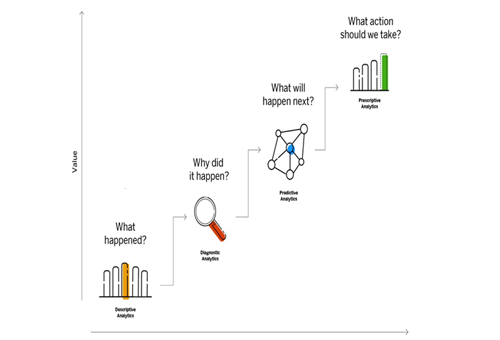Analytics
What is SAP Analytics Cloud?
SAP Analytics Cloud combines BI, planning, predictive, and augmented analytics capabilities into one simple cloud environment. Powered by AI technologies and an in-memory database, it is one of the most advanced analytics solutions available today.Engineering
What Is Analytics?
Every day, organisations, individuals, and items generate vast amounts of data. We
collectively send 294 billion e-mails and 500 million tweets in a 24-hour cycle. We plug 3.5
billion searches into Google. Four petabytes of data is produced by our connected cars. And
our watches, refrigerators, and televisions create and share data on a regular basis.
A basic definition of analytics
Analytics is a branch of computer science that seeks out relevant trends in data using math,
statistics, and machine learning. Sifting through vast datasets to discover, analyse, and
share new insights and information is what analytics – or data analytics – is all about.
What is business analytics?
Simply put, business analytics is the application of analytics to business data. It focuses
on the business implications of data, as well as the decisions and actions that should be
made as a result of those implications.
The importance of business analytics
Today, the use of business analytics software is often the deciding factor distinguishing industry winners from losers. Leading companies use analytics to monitor and optimize every aspect of their operations – from marketing to supply chain – in real time. They rely on analytics to help them make fast, data-driven decisions, grow revenue, establish new business models, provide five-star customer experiences, empower employees, gain a competitive edge, and so much more. Companies without analytics – or without good analytics – are left to make decisions and do business based on gut instinct and experience alone.
- Improved efficiency and productivity
- Faster, more effective decision-making
- Better financial performance
- Identification and creation of new revenue streams
- Improved customer acquisition and retention
The top business benefits of analytics are:

Four types of analytics
Deliver better customer experiences with intelligent sales, with one system for all order management, and customer interactions. Supporting end-to-end process for selling solution packages offered in a single quote and invoice.
Descriptive, diagnostic, predictive, and prescriptive analytics are the four forms of analytics. This super tool kit, when used together, will provide decision-makers with a comprehensive understanding of what is happening, why it is happening, what will happen next, and what to do about it – in every situation.Examples of analytics
Analytics is used by companies of all sizes and in a variety of sectors. Many analytics tools are specialised for a particular market, function, or line of business. Here are a few examples of today's analytics:
Financial analytics
Financial analytics has traditionally been used to generate a regular collection of results.
Financial analytics has grown as finance has taken on a more strategic role in the market,
integrating financial and operational data with external data sources to answer a broad
variety of business questions.
Marketing analytics
Marketing analytics combines data from a variety of sources, including social media, the
Web, e-mail, smartphone, and more, to provide marketers with a holistic view of their
campaigns' performance. Users can mine millions of rows of data to increase campaign
effectiveness, hyper-personalize marketing messages, evaluate social media sentiment, target
potential customers at precisely the right time, and more.
Supply Chain Analytics
They optimise everything from sourcing, manufacturing, and inventory to transportation and
logistics using real-time data from a variety of sources, including Internet of Things
sensors.
Response and Supply Planning
Create and maintain supply plans aligned with business goals as demand and supply change
Modern analytics technologies
The era of artificial intelligence (AI) and machine learning has arrived, thanks to
virtually limitless data storage and lightning-fast processing speeds. Analytics are being
“augmented” by these developments, making them infinitely more efficient than before.
AI and machine learning analytics can identify trends, locate outliers, and make
correlations in Big Data much more quickly and accurately than ever before. They can use the
cloud to access more data from more sources, such as social media and Internet of Things
sensors, to uncover insights, opportunities, and threats that would otherwise go unnoticed.
Machine learning algorithms can even simplify some of the most difficult steps in the
analytics process, allowing even non-data scientists – not just data scientists – to use
advanced and predictive analytics.
All of this, of course, is accessible through mobile devices, allowing users to get answers
to ad hoc questions no matter where they are.
What is Advanced analytics?
Advanced analytics refers to a form of analytics that employs sophisticated tools and
techniques to explore data autonomously (or semi-autonomously). Predictive modelling, data
and text mining, sentiment analysis, machine learning, neural networks, statistical
algorithms, and complex event processing are examples of technologies and techniques that go
beyond conventional BI capabilities.
What is Big Data analytics?
Big Data analytics is a form of advanced analytics that analyses very large datasets from a
variety of sources, including structured, semi-structured, and unstructured data. Big Data
analytics can uncover hidden patterns, unknown correlations, and other meaningful insights
in datasets using complex tools and techniques like predictive modelling, what-if analysis,
and machine learning algorithms.
What is Augmented analytics?
These powerful AI-driven analytics democratise advanced analytics by automating complex
processes and allowing users to ask questions and understand answers with minimal training.
